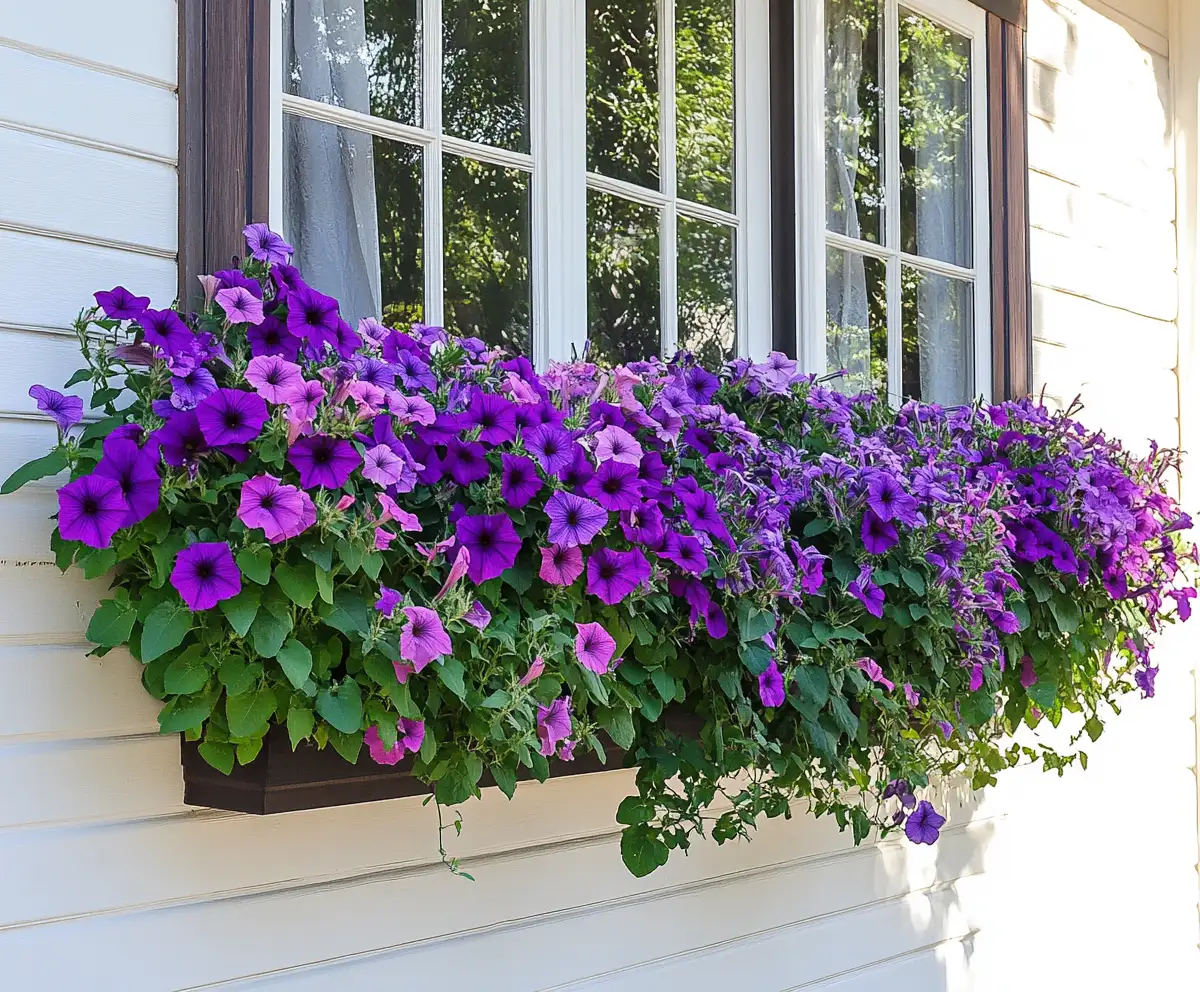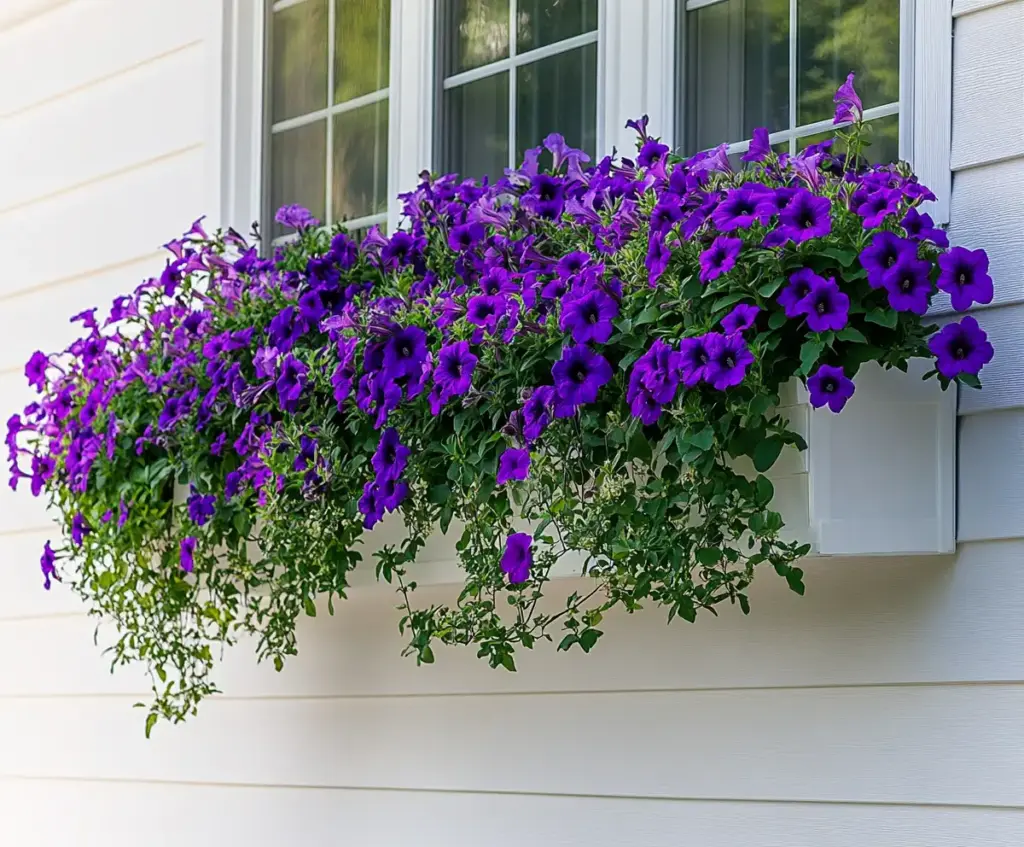Looking to boost your home’s curb appeal without a major renovation? Window flower boxes are the perfect solution. With just a bit of planning, you can turn plain windows into colorful, cascading showcases that brighten your home from spring all the way through fall. Whether you’re a seasoned gardener or a weekend DIYer, these charming planters offer an easy way to bring texture, color, and life to your exterior.
After years of trial and error, I’ve discovered the best combinations of soil, flowers, and vines that thrive in window boxes—especially in spots with 5 to 6 hours of morning sun. In this guide, I’ll walk you through how to create and maintain vibrant window flower boxes using a tried-and-true method that ensures your plants not only survive but truly flourish across multiple seasons.
Choosing the Right Soil for Window Boxes
Before you pick out flowers or start arranging your planter, it’s essential to start with the right foundation—quality potting soil. Unlike garden soil or topsoil, potting soil is specifically designed to promote airflow and proper drainage in containers, helping plant roots grow freely without getting compacted.
Why Potting Soil Matters
- It’s lightweight and retains moisture without becoming soggy.
- It often includes slow-release fertilizers to give your plants a healthy start.
- It prevents root rot by allowing excess water to drain efficiently.
Each spring, it’s a good idea to refresh your window box soil. You don’t necessarily need to replace it all—removing old root balls and mixing in one-third to one-half fresh potting soil can rejuvenate the mix, reintroduce nutrients, and promote strong seasonal growth.
🚫 Avoid topsoil or garden dirt. These are too dense for container gardens and can quickly lead to poor drainage and compacted roots.
The “Thrill, Fill, Spill” Formula for Beautiful Flower Boxes
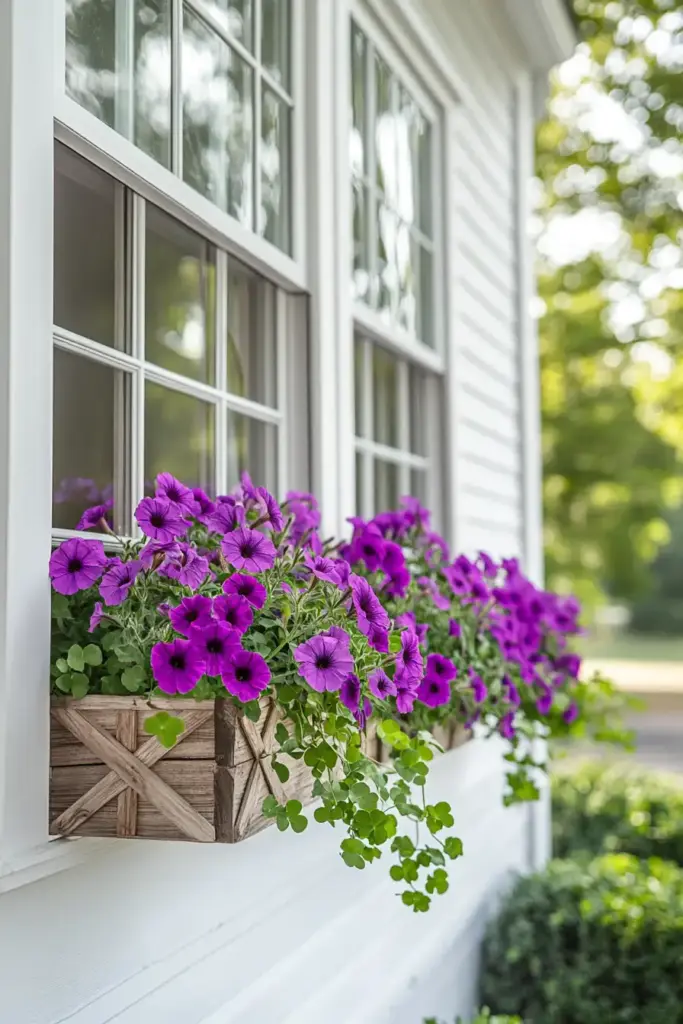
Want to know the secret behind lush, professional-looking window flower boxes? It’s all about mastering the “Thrill, Fill, Spill” technique. This design method creates balance, visual interest, and a cascading effect that looks fantastic from the street and up close.
Here’s how it works:
- Thrill: These are your statement plants—the tall, bold blooms that stand out and give your arrangement height and drama.
- Fill: These mid-level plants add volume and color, rounding out the look and filling in any gaps.
- Spill: These are your trailing plants, the ones that tumble over the edges and create a soft, flowing feel.
Using this combination ensures that your window boxes are full, dynamic, and eye-catching from every angle. Below, we’ll go over the best options for each category, so you can mix and match according to your taste and climate.
Best “Thrill” Flowers (Height & Focal Point)
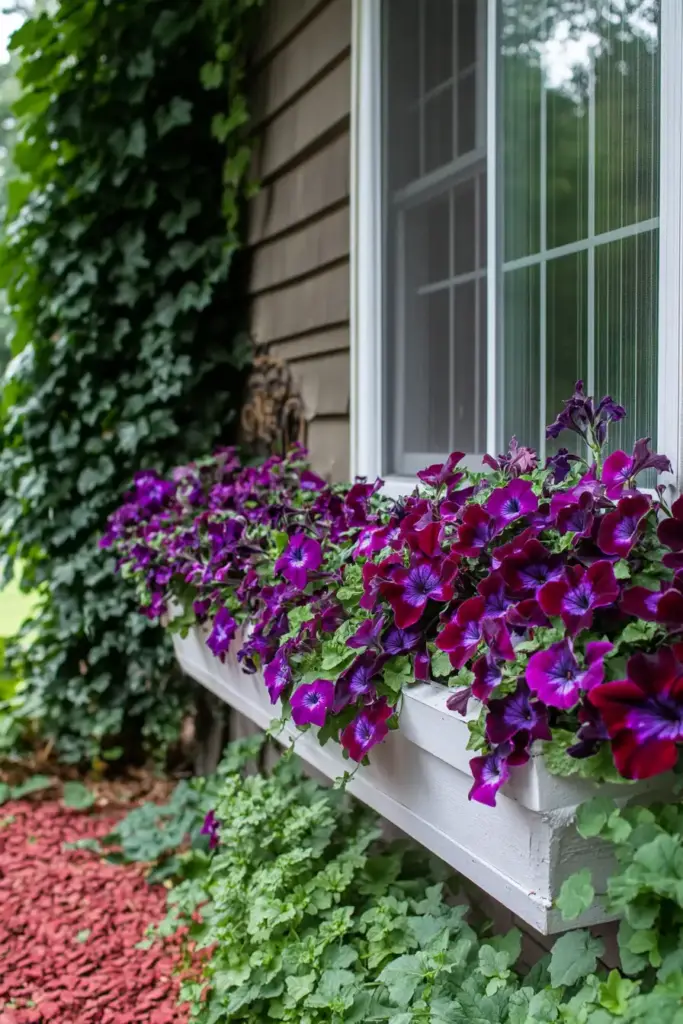
The “thrill” plants are your headliners—the bold blooms that catch the eye and give your window boxes that wow factor. These flowers typically grow upright and provide structure and vibrant color to your arrangement.
Here are some standout options:
- Supertunias (Proven Winners): These are not your average petunias. They grow quickly, bloom profusely, and come in a variety of bold shades. They’re heat-tolerant and self-cleaning, making them ideal for low-maintenance gardeners.
- Petunias: A classic choice, petunias are available in almost every color imaginable. They love the sun and bloom heavily, adding instant cheer to any box.
- Geraniums: Known for their bold blooms and upright habit, geraniums offer vibrant reds, pinks, and purples. They’re drought-tolerant and thrive with regular deadheading.
🪴 Pro Tip: Place your thrillers in the center if your box is visible from multiple sides, or toward the back if it’s viewed from the front only.
Best “Fill” Plants (Volume and Color)
Now that you’ve chosen your show-stopping thrillers, it’s time to bring in the fillers—the plants that add body, texture, and rich color to your window boxes. These mid-height blooms and foliage fill in the gaps between the taller focal plants and the trailing vines, helping your arrangement feel lush and cohesive.
Here are some of the best options to consider:
- Marigolds: These sun-loving annuals are not only vibrant but also naturally pest-repellent. Their golden and orange hues add warmth and contrast beautifully with purples and reds.
- Ageratum: With soft, fluffy blue or purple flowers, ageratum adds a cool tone and a unique texture to your planter.
- Pansies: Ideal for early spring or cooler climates, pansies bring cheerful color and charming “faces” that make them a perennial favorite. They also work well with more delicate thrillers.
- Impatiens: Perfect for shadier spots, impatiens offer a continuous burst of color throughout the season and pair well with just about any other flower.
🌿 Tip: Choose fillers in complementary or contrasting colors to your thrillers for a bold, balanced look.
Best “Spill” Plants (Trailing and Cascading)
To complete the trio, it’s time to pick your “spill” plants—the trailing vines and cascading flowers that soften the edges of your window boxes and create a lush, overflowing effect. These plants hang gracefully over the sides, adding depth, texture, and a natural sense of movement to your display.
Top picks for spillers include:
- Creeping Jenny: This vibrant chartreuse vine adds a striking pop of green and contrasts beautifully with colorful flowers. It grows quickly and cascades elegantly over the edge of any container.
- Vinca Vines: With their glossy, variegated leaves, vinca vines add a touch of elegance and can handle both sun and partial shade.
- Sweet Potato Vines: Known for their bold leaf colors—lime green, deep purple, even black—these fast-growing vines bring a dramatic, tropical vibe to your arrangement.
- Trailing Verbena: Offering a cascade of small blooms in pink, purple, or white, verbena is perfect for adding extra floral appeal while also attracting pollinators.
When to Plant Your Window Boxes

Timing your planting right is just as important as picking the perfect plants. Planting too early can expose your flowers to frost, while planting too late can shorten your blooming season. So when’s the sweet spot?
Ideal Planting Time
In most temperate regions, especially in the Northeast U.S. (like New England), the best time to plant window boxes is mid to late May—right after the threat of the last frost has passed. A good rule of thumb is to aim for the weekend before Memorial Day, which gives your plants a warm, stable environment to settle in and grow.
🌡️ Check your local frost dates if you’re outside New England. Use a gardening app or a regional planting guide to find your zone-specific schedule.
🌼 Bonus Tip: If you’re eager to get started earlier in the season, consider using cold-hardy flowers like pansies or violas until you can safely transition to heat-loving plants.
Feeding and Maintaining Your Plants
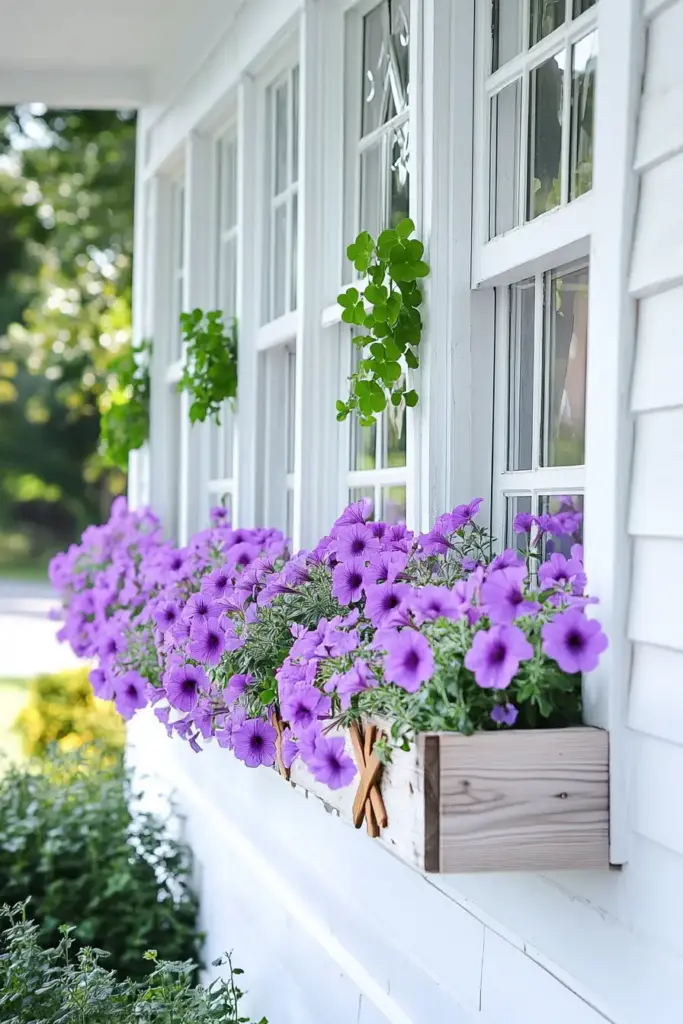
Once your window flower boxes are planted, the real magic happens through consistent care. Sunlight and water are essential, but to keep your blooms vibrant and full all season long, feeding your plants regularly is the secret weapon.
How Often Should You Feed?
For optimal growth, feed your flowers every 7 to 10 days. Consistent feeding helps your plants grow bushier, produce more blooms, and resist stress from heat or lack of rain.
- Water-soluble plant food is ideal—just mix it into your watering can and pour directly into the soil.
- If you’re prone to forgetting (hey, life happens), aim for at least once a month. Even that makes a noticeable difference.
Top Fertilizer Picks:
- Jack’s Classic Plant Food – Known for fast, vibrant growth and easy use.
- Miracle-Gro All Purpose Plant Food – A classic for a reason, it’s affordable, effective, and widely available.
💡 Pro Tip: Feed in the morning when the sun is less intense. This allows your plants to absorb nutrients without the risk of burn.
Don’t Forget Watering
Window boxes tend to dry out faster than ground beds—especially in full sun. Be sure to water once daily in hot weather, and check the soil moisture regularly. A good soak should keep your plants happy and hydrated.
Building vs. Buying Window Boxes
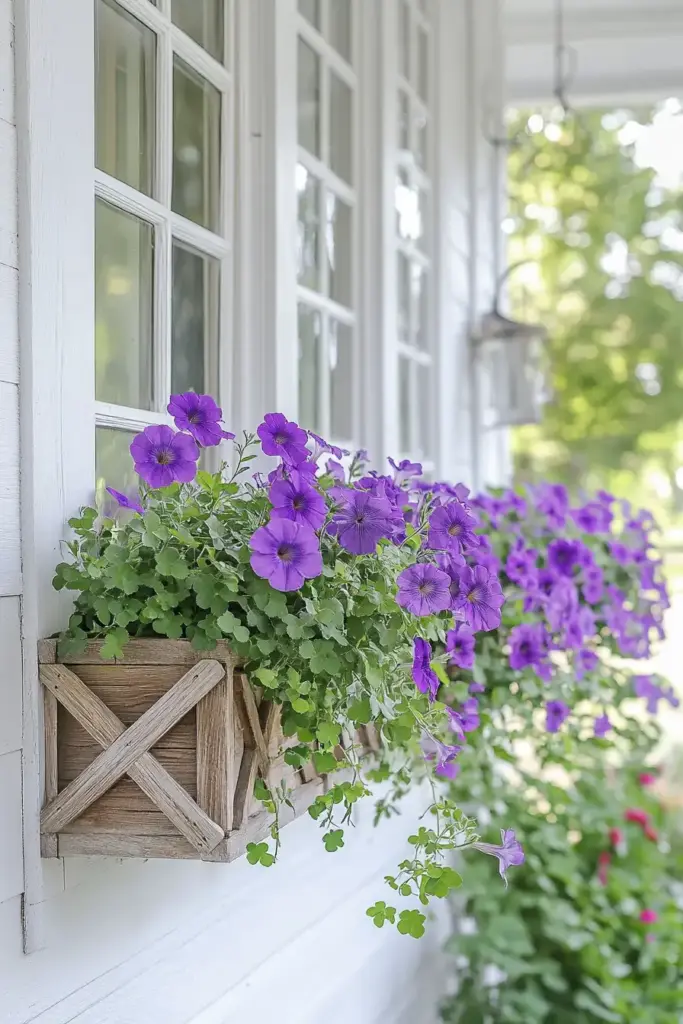
Creating the perfect window flower box display doesn’t stop at the plants—you’ll need a sturdy, attractive container to show them off. Whether you’re a hands-on DIYer or just want a ready-to-go option, there are solid choices for every skill level and budget.
Building Your Own Window Boxes
If you’re into weekend projects, building your own boxes lets you customize the size, materials, and finish to match your home perfectly.
DIY Tips:
- Materials: Use cedar for the sides—it’s naturally rot-resistant. For the bottom, pressure-treated wood works well to withstand moisture.
- Assembly: Screw the boards together with outdoor wood screws, and make sure to drill drainage holes in the bottom to prevent soggy soil.
- Finishing Touch: Apply a coat of marine-grade spar varnish to protect against weather and give your boxes a clean, polished look.
- Mounting: For that “floating” appearance without visible brackets, use strong metal L-brackets underneath to support the weight discreetly.
🛠️ Bonus: DIYing gives you full creative control—paint, stain, or stencil to match your home’s aesthetic.
Prefer to Buy?
Not into sawdust and screwdrivers? No problem. There are plenty of beautiful, pre-made window boxes available online and at home improvement stores.
Look for:
- Weather-resistant materials like PVC, resin, or treated wood
- Built-in drainage systems
- Brackets or mounting kits included for easy installation
💡 Shopping Tip: Match the box style with your home’s exterior—classic white for colonial homes, rustic wood for farmhouse vibes, or sleek black for a modern touch.
Conclusion
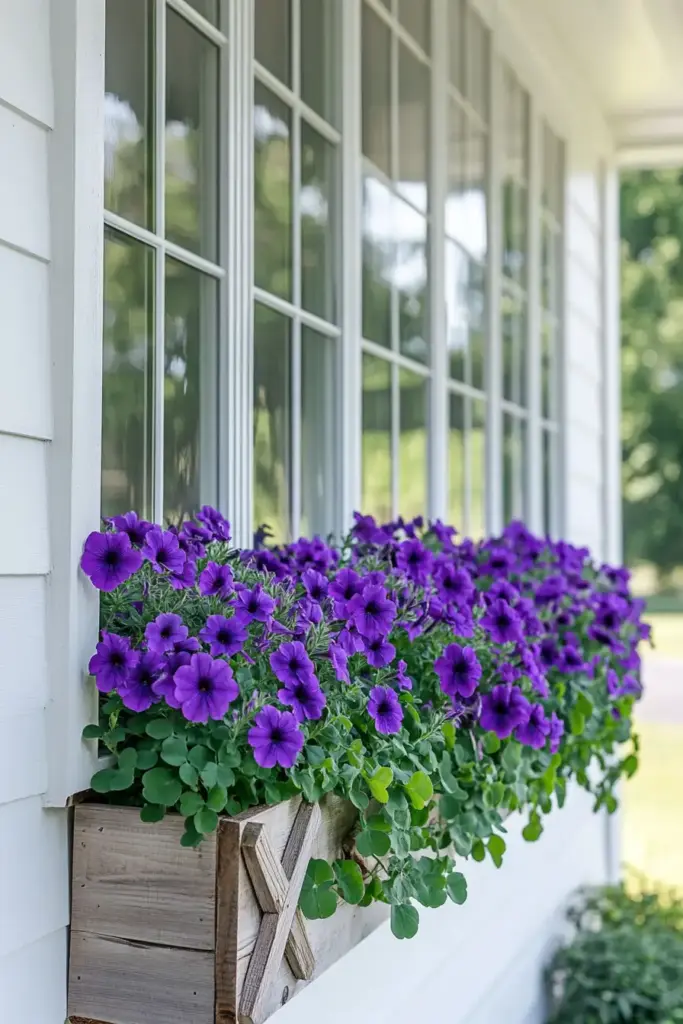
Adding window flower boxes to your home is one of the easiest—and most rewarding—ways to elevate your curb appeal and enjoy gardening in small spaces. By using the Thrill, Fill, Spill method, choosing the right plants for your light conditions, and giving them consistent care, you’ll have vibrant, cascading blooms that last from early spring well into the fall.
Whether you build your own boxes for that custom look or purchase ready-made ones, the key is in thoughtful planting and regular maintenance. Feed your plants, keep them hydrated, and don’t be afraid to swap in seasonal blooms for a fresh twist.
So grab your trowel, pick your favorite flowers, and get planting—your windows (and neighbors) will thank you.

